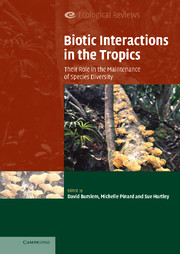Book contents
- Frontmatter
- Contents
- List of contributors
- Preface
- PART I Plant–plant interactions
- PART II Plant–microbe interactions
- 6 Dimensions of plant disease in tropical forests
- 7 Mycorrhizas and ecosystem processes in tropical rain forest: implications for diversity
- 8 An overview of arbuscular mycorrhizal fungal composition, distribution and host effects from a tropical moist forest
- 9 Tropical plants as chimera: some implications of foliar endophytic fungi for the study of host-plant defence, physiology and genetics
- PART III Plant–animal interactions
- PART IV Biotic interactions in human-dominated landscapes
- Index
- References
7 - Mycorrhizas and ecosystem processes in tropical rain forest: implications for diversity
Published online by Cambridge University Press: 25 August 2009
- Frontmatter
- Contents
- List of contributors
- Preface
- PART I Plant–plant interactions
- PART II Plant–microbe interactions
- 6 Dimensions of plant disease in tropical forests
- 7 Mycorrhizas and ecosystem processes in tropical rain forest: implications for diversity
- 8 An overview of arbuscular mycorrhizal fungal composition, distribution and host effects from a tropical moist forest
- 9 Tropical plants as chimera: some implications of foliar endophytic fungi for the study of host-plant defence, physiology and genetics
- PART III Plant–animal interactions
- PART IV Biotic interactions in human-dominated landscapes
- Index
- References
Summary
Introduction
The roots of almost all species of tropical rainforest trees contain mycorrhizal fungi (Alexander 1989a). Our aim here is to demonstrate that not only are these fungi central to ecosystem processes such as carbon- and nutrient-cycling, but that they also have the potential to influence biotic interactions between species, and so help to shape the structure and composition of forest communities. As such, they should be of interest to all ecologists, not just those who are primarily concerned with nutrient dynamics.
Mycorrhizas have continued to be the subject of intensive research in the 15 years since we last reviewed their role in tropical rain forest (Alexander 1989a). The processes by which mycorrhizal fungi access mineral nutrients in natural substrates are more fully understood, and important functional differences between types of mycorrhiza have been recognized (Read & Perez-Moreno 2003). There have been major advances in our understanding of the role of mycorrhizal fungi in forest carbon cycles. In boreal forest, for example, 20%–30% of current assimilate is consumed by mycorrhizal fungi (Söderström 2002), over 50% of CO2 released from soils is accounted for by the respiration of tree roots and their associated mycorrhizal fungi (Högberg et al. 2001) and 30% of the soil microbial biomass is the extraradical hyphae of mycorrhizal fungi (Högberg & Högberg 2002). There is also growing evidence that mycorrhizal associations are multifunctional, and that benefit to the host may not accrue solely or entirely through enhanced capture of mineral nutrients (Newsham et al. 1995a).
- Type
- Chapter
- Information
- Biotic Interactions in the TropicsTheir Role in the Maintenance of Species Diversity, pp. 165 - 203Publisher: Cambridge University PressPrint publication year: 2005
References
- 52
- Cited by



